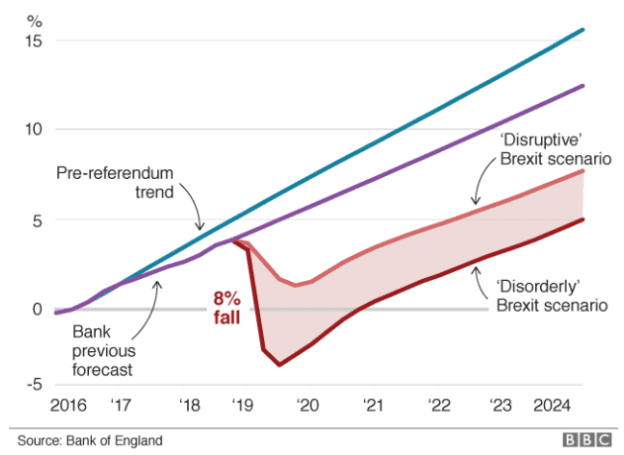Last Updated on January 11, 2019
The process of separation between the United Kingdom and the European Union is nearing its end. The final debate in the British Parliament began on January 7th and will conclude on the 14th with a closing vote. This discussion should have been had on the 11th of December, however Prime Minister Theresa May cancelled the vote the day before to gain time for another try at re-negotiating the terms of their departure with Brussels. This attempt was unsuccessful. The EU expected London to be the one to propose a new offer, since they themselves had no intention of changing the original agreement. Unfortunately, neither did Prime Minister May. What she did achieve, was a formal vote of confidence from the Parliament that allowed her to delay the decision while also strengthening her position.
Britain’s parting from the EU, or Brexit as it’s popularly known, is the dissolution of a 50 years old political and economic alliance. It’s only natural that it would involve much more work and difficulty than those in favor of it had initially thought. Brexiters successfully campaigned on preserving British independence and swayed the majority of the population. Even so there were only a select few of them who would’ve been willing to take charge of the negotiations necessary to bring it to fruition. It was obvious from the beginning that building a consensus on the matter would be outright impossible. Enter Theresa May, who came out of the blue and stepped up to the task when no Brexiter would. During these negotiations many of the arguments in favor of Brexit turned out to be untenable. The EU does not guarantee access to their market if the free flow of goods and services is halted. The US did not offer them an exceptionally favorable trade deal either. Instead of these promises being fulfilled, voters were faced with their own political elite being incapable of cooperation ever since.
The Bank of England (BoE) released its own estimates of Brexit’s expected effects during the tail end of last year. Even though there’s still two and a half months before the separation, the central bank’s analysts already have a good idea of its economic effects based on the period following the referendum. Although such an analysis may have been more useful before the referendum itself, the BoJ opted to not take a stance in that tense political climate, since they estimated the possibility of the vote passing to be very low.
The BoE outlined two separate scenarios, each compared to what would’ve been if UK had chosen to remain a part of the EU.
- “Disruptive”, as in an exit based on an agreement.
- “Disorderly”, as in a no-deal Brexit.
The central bank already expected the prospects for economic growth to decline even before the referendum, however, these latest reports depict a much harsher aftershock than previously anticipated.

According to the statements made by Mark Carney, the Governor of the BoE, neither the country’s industry nor its infrastructure are prepared for the withdrawal. In the no-deal version the country would be left with no international trade agreements from one moment to the next, since all the ones they have with third parties were signed as EU members, making them null and void on exit. In the BoE’s estimation, this would isolate the UK not just from the rest of Europe, but the entire global trade network. Having to build this network of agreements from the ground up could take years, during which domestic companies would be limited in their ability to enter foreign markets. This is the primary factor underlying the 8% drop in economic growth and it could potentially throw the country into a recession before the end of the year, one they would have a hard time recovering from any time before 2021. If that were to happen other sectors besides industry would collapse as well. The BoE predicts that housing prices would drop by 30% and commercial real estate by 48% in England. Unemployment would double and inflation could reach 6.5%, necessitating a 4.5% base interest rate and even that wouldn’t be enough to stop the pound’s depreciation.
All in all it looks like the script to a disaster movie and at the same time it’s also a powerful argument that could give Theresa May a great deal of support during the upcoming critical Parliamentary vote. The central bank’s assertion will no doubt be on the mind of every single representative who has to cast a vote that day. Brexiters are still sticking to their guns and consider the BoE’s analysis merely an attempt to cause panic. The populace on the other hand is starting to have second thoughts as protests are being organized to pressure the members of Parliament into only withdrawing with an exit deal. Now that the Prime Minister has the central bank behind her to support her position, chances of a more orderly exit are on the rise. British government’s current playbook may be far from ideal, however, it’s nowhere near as intimidating as the potential consequences of a no-deal Brexit.
For now the government has organized a major attempt at trying to reinstate customs control on their borders for early 2019 to see what it would take to do so in the case of no-deal. This has become a pressing matter, since recent forecasts suggest a line of trucks stretching from Dover to Calais. The potential traffic congestion at the country’s point of entry could lead to a notable disruption of supply within Britain. While the result of the test has not been announced yet, the message is clear: there is a very real possibility of a disorderly exit.
